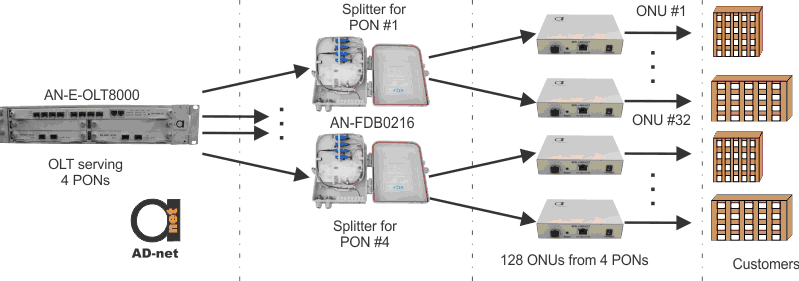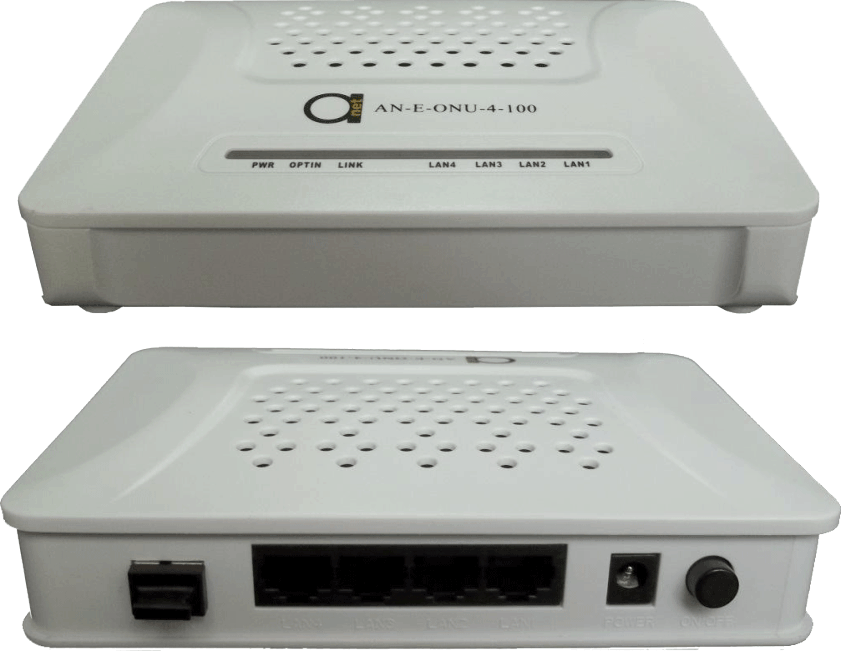OLT and ONT – what are their roles in GPON network?
OLT (Optical Line Terminal)
OLT and ONT? Lets start with OLT then. The main function of OLT is to control the information float across the ODN, going both directions, while being located in a central office. Maximum distance supported for transmitting across the ODN is 20 km. OLT has two float directions: upstream (getting an distributing different type of data and voice traffic from users) and downstream (getting data, voice and video traffic from metro network or from a long-haul network and send it to all ONT modules on the ODN.

As we see from the figure, OLT is designed for controlling more than one PON (in this example it serves for four independent networks). We can see that if every PON has 32 connections, OLT can distribute data to 128 ONTs. OLT has specific standard, so it would work with ONT from different manufacturers.
Different service types are sent separately, but simultaneously using different wavelengths. Wavelengths are shown in the table:

ONT (Optical Network Terminal), also ONU (Optical Network Unit)
ONT location, as seen from the figure, is at the customer’s premises. Its purpose is to use optical fiber for connecting to the PON on the one side, while interfacing with customers on the other side. ONT supports wide variety of interfaces, depending on requirements of customer:
- Digital video formats
- Analog video formats
- ATM interfaces (155 Mbps)
- DS3 or E3 telephone connections (44.736 or 34.368 Mbps)
- T1 or E1 (1.544 or 2.048 Mbps)
- Various Ethernet rates

Picture 1: AD-net 4 Fast Ethernet port ONU (Optical Network Unit)
Functional design and chassis configuration of ONT vary depending on customer needs and requirements. The size of it can range from simple, small box, being attached outside the house to large unit mounted inside the large office building or apartment complex. ONT (Optical Network Unit) can do variety of operations for optimisation of performance. It can also send, aggregate and groom different types of data coming from customer and send it upstream to the OLT. Grooming is the process that optimises and reorganises the data stream so it would be delivered more efficient. OLT supports bandwidth allocation that allows to make smooth delivery of data float to the OLT, that usually arrives in bursts from customer.
Can be located also somewhere outside in the equipment shelter. That’s why ONU (Optical Network Unit) should be specified so it can be working in different temperature and weather conditions. It should resist water, winds and vandals. For the situation when the power is off there should be an emergency battery backup. For normal case there should be a power source. ONU could be connected by various methods and cable types, like twisted-pair copper wire, coaxial cable, optical fiber or Wi-Fi.
You can explore our GEPON range here: https://www.ad-net.com.tw/products/#gepon-epon-fiber-optical-access


